The beginning of 20th Century was the "golden era" of Riga city. In less than 20 years, city's population doubled, reaching half a million. This period concided with a time when art nouveau was the hottest new trend in architecture. That's why Riga got hundreds of new buildings in this style, creating the most dense art nouveau concentration in the world.
Art Nouveau in Riga is very various - from decorative eclecticism exmaples by architect Mikhail Eisenstein to very different national romanticism, rational or vertical art nouveau examples, sometimes - very ascetic ones.
Which of all these buildings are the most impressive, beautiful, interesting or just unusual art nouveau examples? The answer, of course, can be only subjective. Here Photoplaces have collected it's own version of the most beautiful art nouveau (apartment) buildings in Riga.
SEE ALSO: Photo gallery of more than 100 Art Nouveau Buildings In Riga
Art Nouveau in Riga is very various - from decorative eclecticism exmaples by architect Mikhail Eisenstein to very different national romanticism, rational or vertical art nouveau examples, sometimes - very ascetic ones.
Which of all these buildings are the most impressive, beautiful, interesting or just unusual art nouveau examples? The answer, of course, can be only subjective. Here Photoplaces have collected it's own version of the most beautiful art nouveau (apartment) buildings in Riga.
SEE ALSO: Photo gallery of more than 100 Art Nouveau Buildings In Riga
TOP 20 MOST BEAUTIFUL ART NOUVEAU BUILDINGS IN RIGA
 Šķūņu street 12/14. One of hardest noticeable Riga's art nouveau pearls. When strolling on the narrow Skunu street, one has to look up sharply to note and appreciate it's beauty. This building was built in 1902, in the collaboration of architect pair Heinrich Scheel and Friedrich Sheffel. It's an early decorative art nouveau example and it's facade ornamentations has almost only flora's motifs - spikes, poppies, jonquils, chestnut leafs. Also freemasons' symbols are visible here, as well as letter "D" as the testimony of building's first owner, the rich businessmann H. Detmann.
Šķūņu street 12/14. One of hardest noticeable Riga's art nouveau pearls. When strolling on the narrow Skunu street, one has to look up sharply to note and appreciate it's beauty. This building was built in 1902, in the collaboration of architect pair Heinrich Scheel and Friedrich Sheffel. It's an early decorative art nouveau example and it's facade ornamentations has almost only flora's motifs - spikes, poppies, jonquils, chestnut leafs. Also freemasons' symbols are visible here, as well as letter "D" as the testimony of building's first owner, the rich businessmann H. Detmann.
 Barona street 11. The main architectural style of this 1901 building is an eclecticism (neobaroque) but
Barona street 11. The main architectural style of this 1901 building is an eclecticism (neobaroque) but 
 Vīlandes street 1. Impressive corner building on Vilandes street 1 is only partially belonging to art nouveau, it's dominated by eclecticism (late neorenaissance, neobaroque and rococo). However, as the art nouveau characteristics are visible on the entrance hall, it's regarded as one of the first signs of art nouveau in Riga. Building has one of most heavily decorated exteriors. It's also remarkable, that many locally famous people has lived there, even the wife of Russian writer Mikhail Bulgakov, who was an archetype of character in Bulgakov's novel "The Master and Margarita".
Vīlandes street 1. Impressive corner building on Vilandes street 1 is only partially belonging to art nouveau, it's dominated by eclecticism (late neorenaissance, neobaroque and rococo). However, as the art nouveau characteristics are visible on the entrance hall, it's regarded as one of the first signs of art nouveau in Riga. Building has one of most heavily decorated exteriors. It's also remarkable, that many locally famous people has lived there, even the wife of Russian writer Mikhail Bulgakov, who was an archetype of character in Bulgakov's novel "The Master and Margarita". 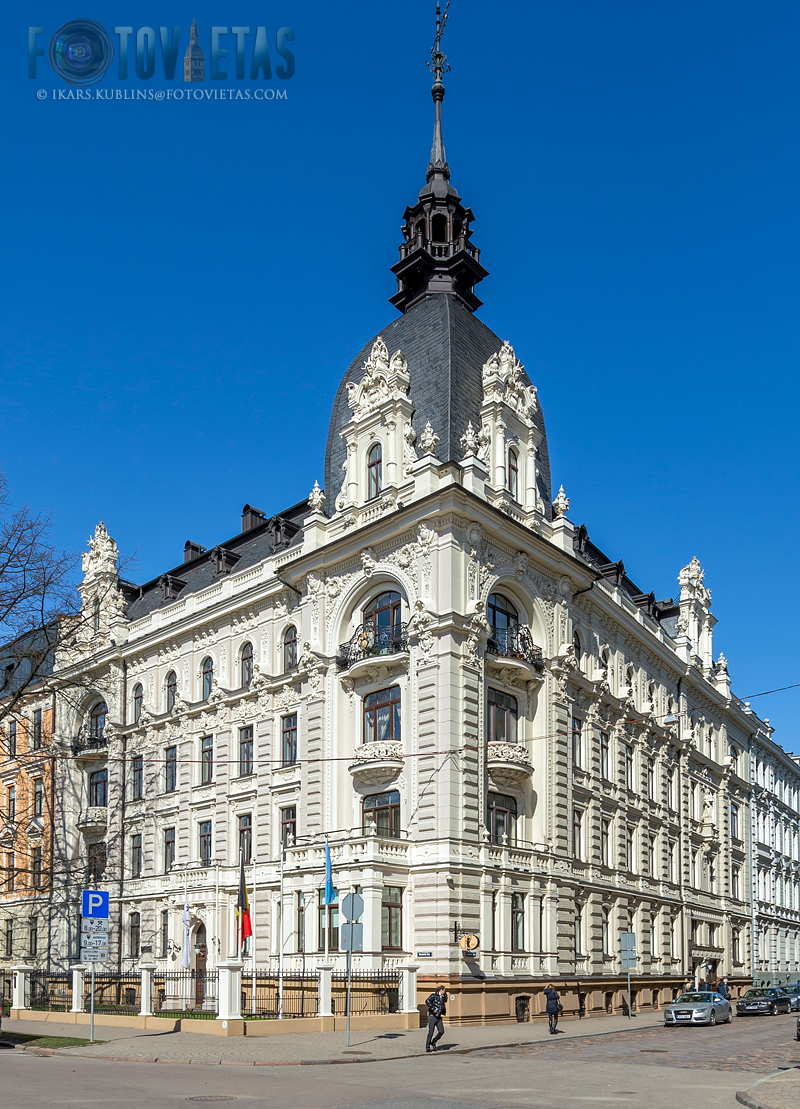
 Elizabetes street 10a. Narrow, brown building on Elizabetes street 10a is a team work of two Riga's art nouveau starchitects - already mentioned Konstantīns Pēkšēns (he was an author of construction design) and famous Mikhail Eisenstein (author of facade design). It's rather a typical Eisenstein's work. One of main eye-catching accents is the large, oval-shaped window on the 5th floor.
Elizabetes street 10a. Narrow, brown building on Elizabetes street 10a is a team work of two Riga's art nouveau starchitects - already mentioned Konstantīns Pēkšēns (he was an author of construction design) and famous Mikhail Eisenstein (author of facade design). It's rather a typical Eisenstein's work. One of main eye-catching accents is the large, oval-shaped window on the 5th floor. 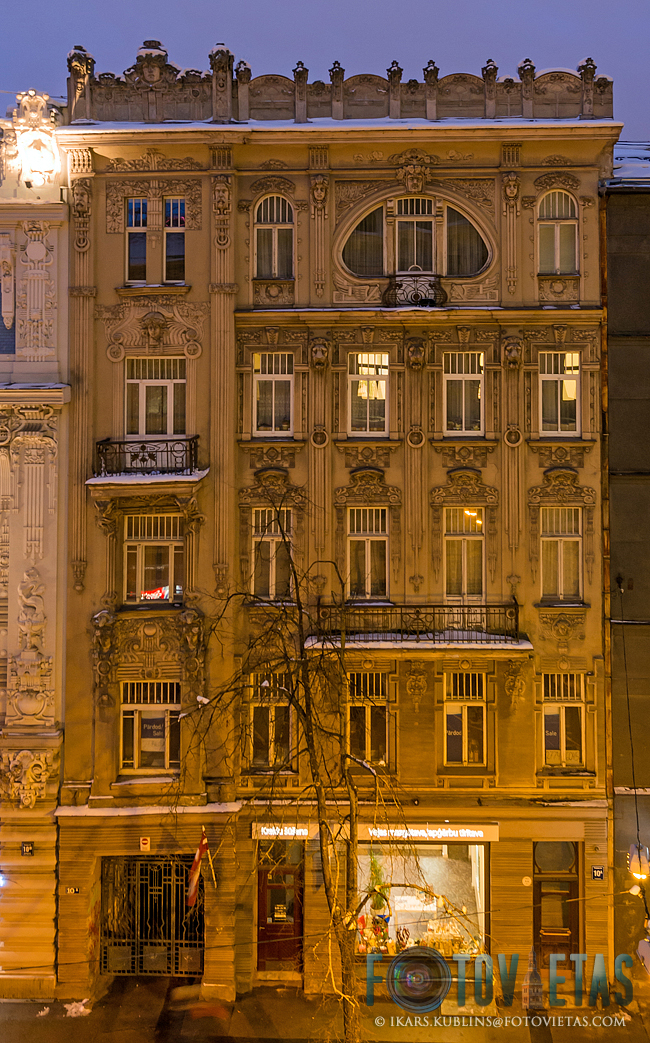
 Rūpniecības street 1. One of most underrated jewels of Riga art nouveau which was built in 1903 after the project of Rudolph von Zirkwitz. The woman figure with lyre is symbolizing the art and the beauty. Indeed, the building seems as a depiction of musical harmony in the language of architecture. If I wouldn't know that actually art nouveau in Vienna looks different I would say that such building would be very suitable in the Austrian capital (as a music citadel).
Rūpniecības street 1. One of most underrated jewels of Riga art nouveau which was built in 1903 after the project of Rudolph von Zirkwitz. The woman figure with lyre is symbolizing the art and the beauty. Indeed, the building seems as a depiction of musical harmony in the language of architecture. If I wouldn't know that actually art nouveau in Vienna looks different I would say that such building would be very suitable in the Austrian capital (as a music citadel). 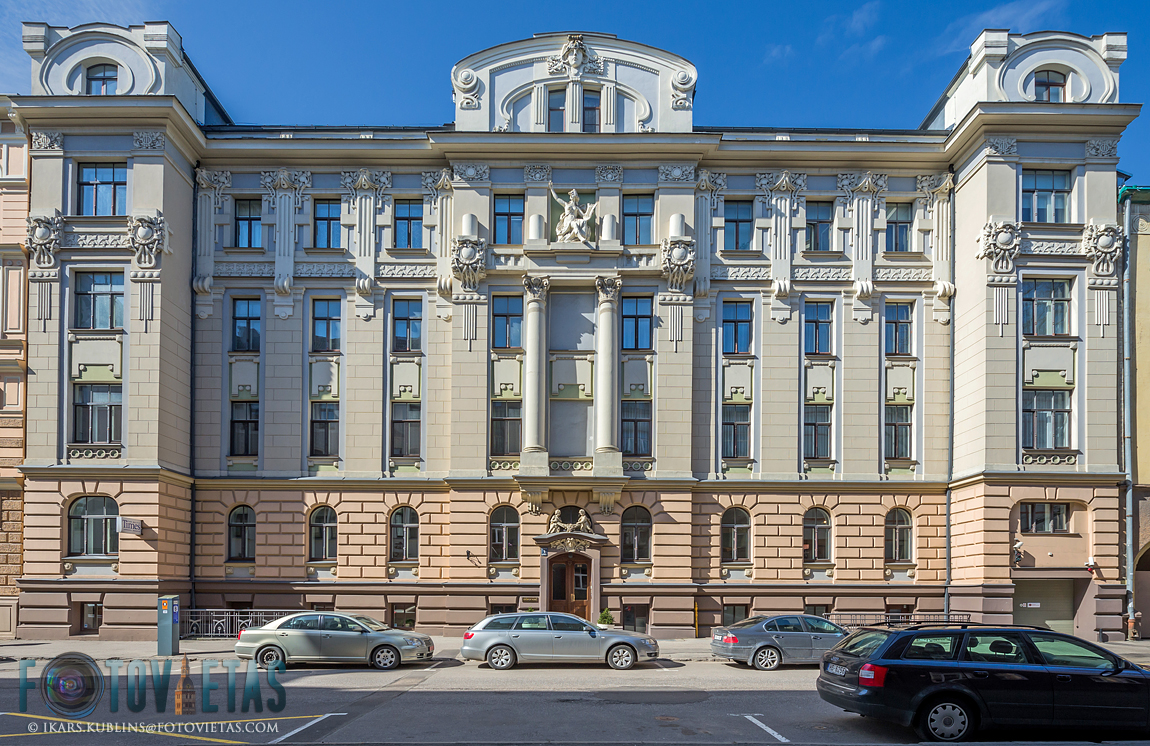
 Strēlnieku street 4a. In opposition to most other Riga centre art nouveau buildings which were built as a tenement houses, this one was planned as a private school. As weird as it sounds, in soviet time the building even housed a students' dorms. Probably it could be written in Guiness records book as the most luxurious building which has been used as a dormitory. Nowadays there's university - Stockholm School of Economics in Riga. Ahh, and the architect? Of course, it's Mikhail Eisenstein and his very ornate expression of art nouveau style.
Strēlnieku street 4a. In opposition to most other Riga centre art nouveau buildings which were built as a tenement houses, this one was planned as a private school. As weird as it sounds, in soviet time the building even housed a students' dorms. Probably it could be written in Guiness records book as the most luxurious building which has been used as a dormitory. Nowadays there's university - Stockholm School of Economics in Riga. Ahh, and the architect? Of course, it's Mikhail Eisenstein and his very ornate expression of art nouveau style.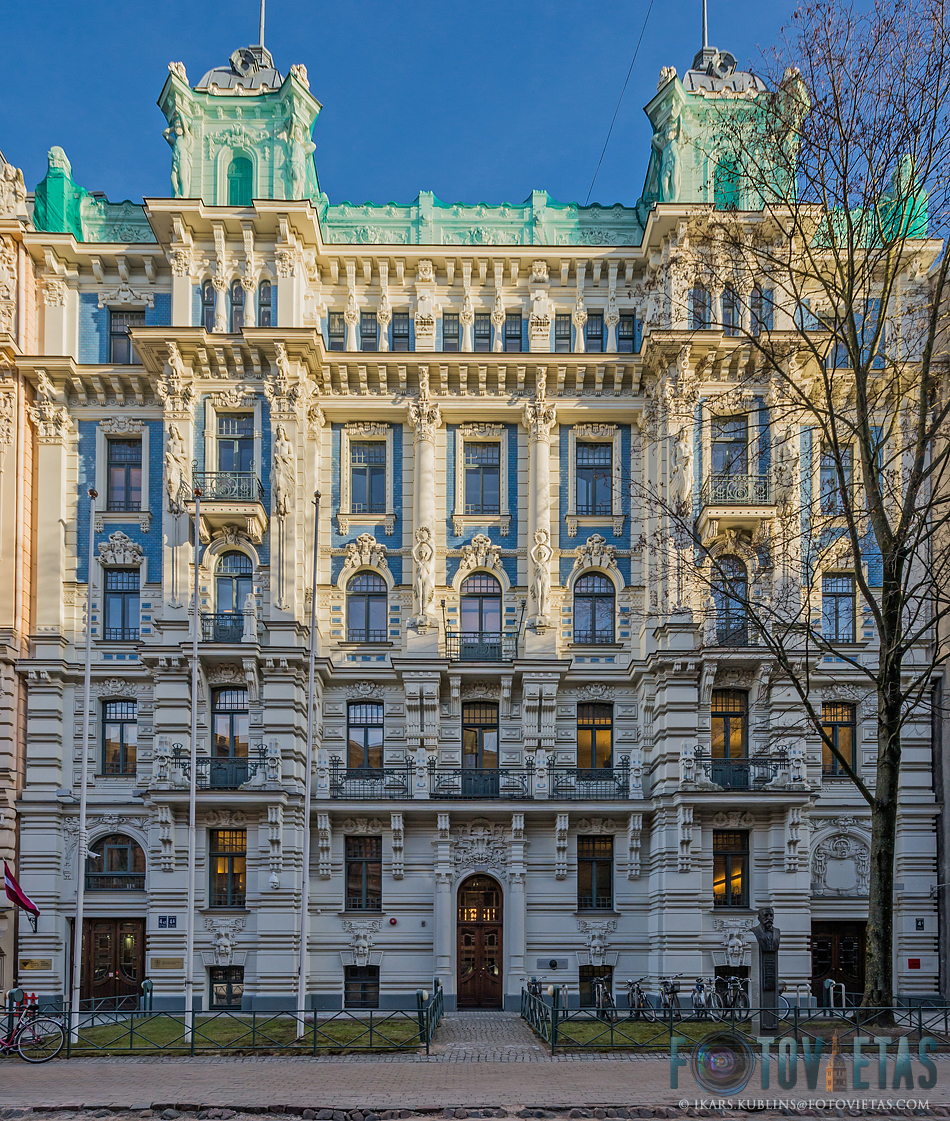
 Smilšu street 8. In Old Town, Smilsu street 8 (Scheffel and Scheel, 1902), there is located very classical and elegant art nouveau building - almost a concentrate of the style. Richly but at the same time not exaggeratedly decorated. It has one of the most beautiful balconies in Riga, with two beauties holding a crown above it (see it in the title photo). The building is generously ornated also with hammered works.
Smilšu street 8. In Old Town, Smilsu street 8 (Scheffel and Scheel, 1902), there is located very classical and elegant art nouveau building - almost a concentrate of the style. Richly but at the same time not exaggeratedly decorated. It has one of the most beautiful balconies in Riga, with two beauties holding a crown above it (see it in the title photo). The building is generously ornated also with hammered works.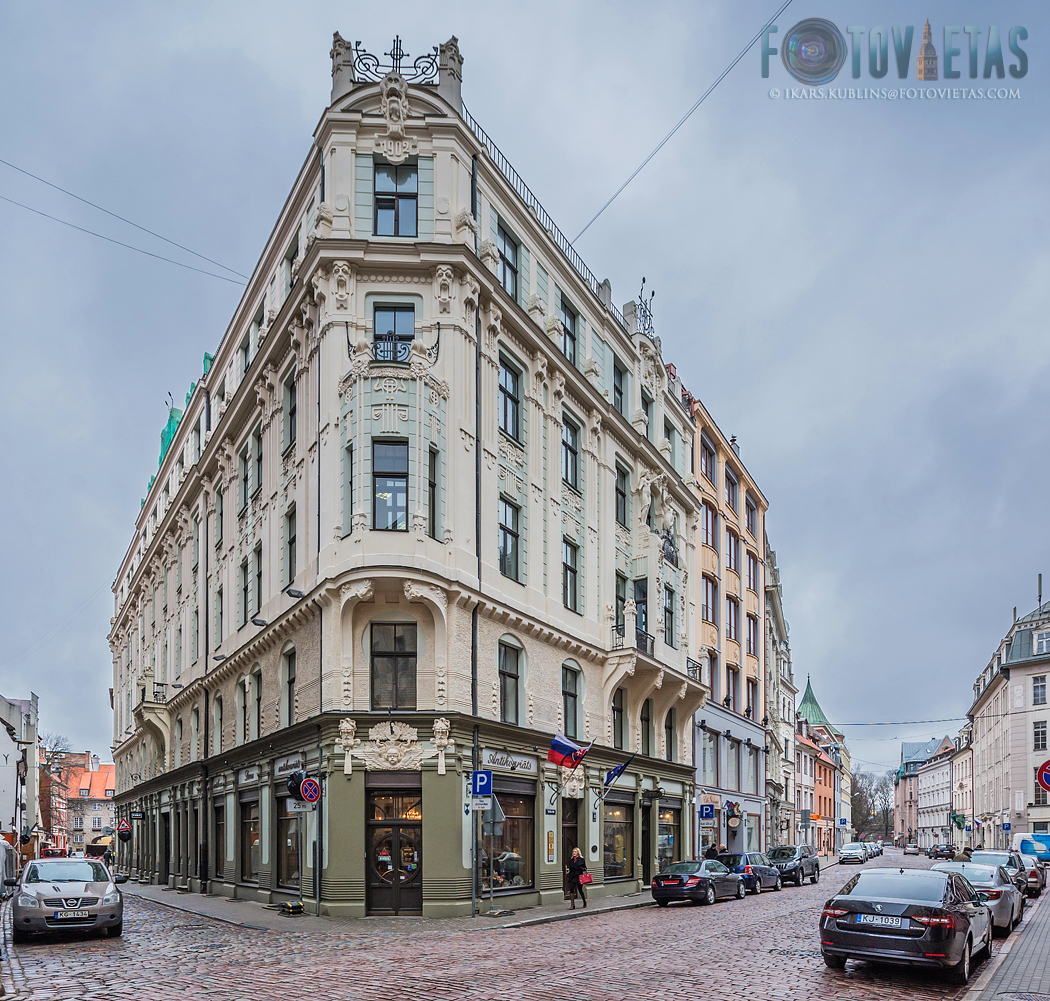
 Alberta street 8. Alberta street 8 was built in 1903 and the architect's name is again Mikhail Eisenstein. The facade is very rich with various sculptures. Here people, plants and animals lives together in harmony, symbolizing mutual interaction. Even characters of ancient Egypt shows up in the common visual symphony (or cacophony?). The facade is interesting also because of the use of blue bricks.
Alberta street 8. Alberta street 8 was built in 1903 and the architect's name is again Mikhail Eisenstein. The facade is very rich with various sculptures. Here people, plants and animals lives together in harmony, symbolizing mutual interaction. Even characters of ancient Egypt shows up in the common visual symphony (or cacophony?). The facade is interesting also because of the use of blue bricks. 
 Miera street 5. This building was clearly ahead of it's time. When didn't knew facts about it, I was assured that it's built in 30ies - in the age of art deco and functionalism. But it turns out that it was built already in 1912! When look more closely, one can spot some art nouveau elements there. The building is unusual also with it's shape - the building exposes itself on the corner of street completely differently. It has no traditional corner gazebo but a sharp edge as well as curved balconies (exactly as in functionalism style) instead.
Miera street 5. This building was clearly ahead of it's time. When didn't knew facts about it, I was assured that it's built in 30ies - in the age of art deco and functionalism. But it turns out that it was built already in 1912! When look more closely, one can spot some art nouveau elements there. The building is unusual also with it's shape - the building exposes itself on the corner of street completely differently. It has no traditional corner gazebo but a sharp edge as well as curved balconies (exactly as in functionalism style) instead.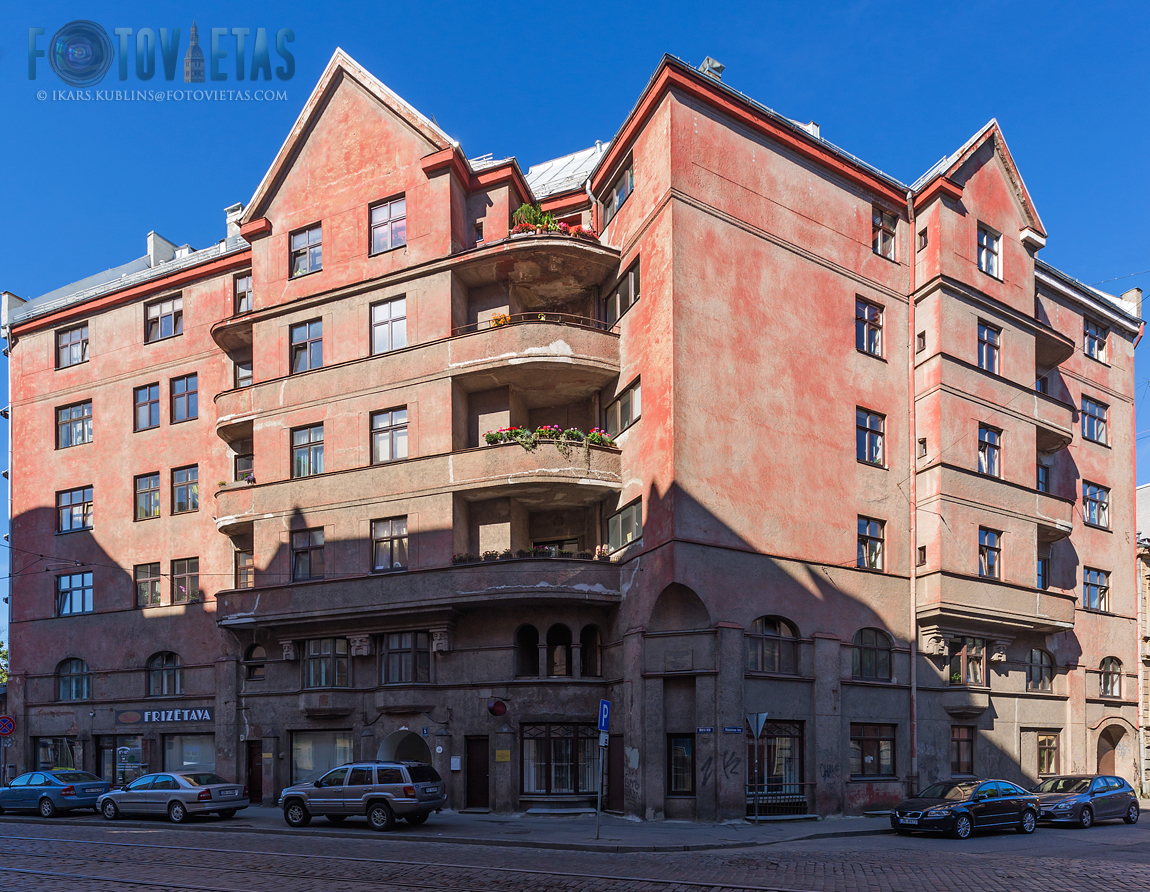
 Skolas street 3. Architect Augusts Reinbergs has written his name in the history of Riga architecture with National Theatre as well as Bank of Latvia buildings. Also the apartment house which he designed and built for himself, on Skolas street 3, is a masterpiece. It's one of most distinctive and unusual examples of Riga's art nouveau which embodies German romanticism and has timberframe (fachwerk) constructions, interesting stone decorations, wonderful balconies, veranda and even loggia.
Skolas street 3. Architect Augusts Reinbergs has written his name in the history of Riga architecture with National Theatre as well as Bank of Latvia buildings. Also the apartment house which he designed and built for himself, on Skolas street 3, is a masterpiece. It's one of most distinctive and unusual examples of Riga's art nouveau which embodies German romanticism and has timberframe (fachwerk) constructions, interesting stone decorations, wonderful balconies, veranda and even loggia. 
 Smilšu street 2. Building on Smilsu street 2 (designed by Konstantīns Pēkšēns, 1902) is named as one of chef d'oeuvres of Riga art nouveau but the woman figure in some beauty contest of stone women in Riga facades was acknowledged as the most beautiful of all. The second statement is disputable (in my opinion, there are many better looking woman figures on Riga facades) but there is no doubt about the first one. Smilsu street 2, which is rebuilt older building, has splendid and unusually manifold decorative layer - in opposition to vast majority of buildings, this one has unique decorations of windows edges on 2nd and 3rd floor level (each one is different). The great visual harmony is achieved also by interplay of red and dark yellow bricks, but on the roof level the color gamut is supplemented also with green.
Smilšu street 2. Building on Smilsu street 2 (designed by Konstantīns Pēkšēns, 1902) is named as one of chef d'oeuvres of Riga art nouveau but the woman figure in some beauty contest of stone women in Riga facades was acknowledged as the most beautiful of all. The second statement is disputable (in my opinion, there are many better looking woman figures on Riga facades) but there is no doubt about the first one. Smilsu street 2, which is rebuilt older building, has splendid and unusually manifold decorative layer - in opposition to vast majority of buildings, this one has unique decorations of windows edges on 2nd and 3rd floor level (each one is different). The great visual harmony is achieved also by interplay of red and dark yellow bricks, but on the roof level the color gamut is supplemented also with green. 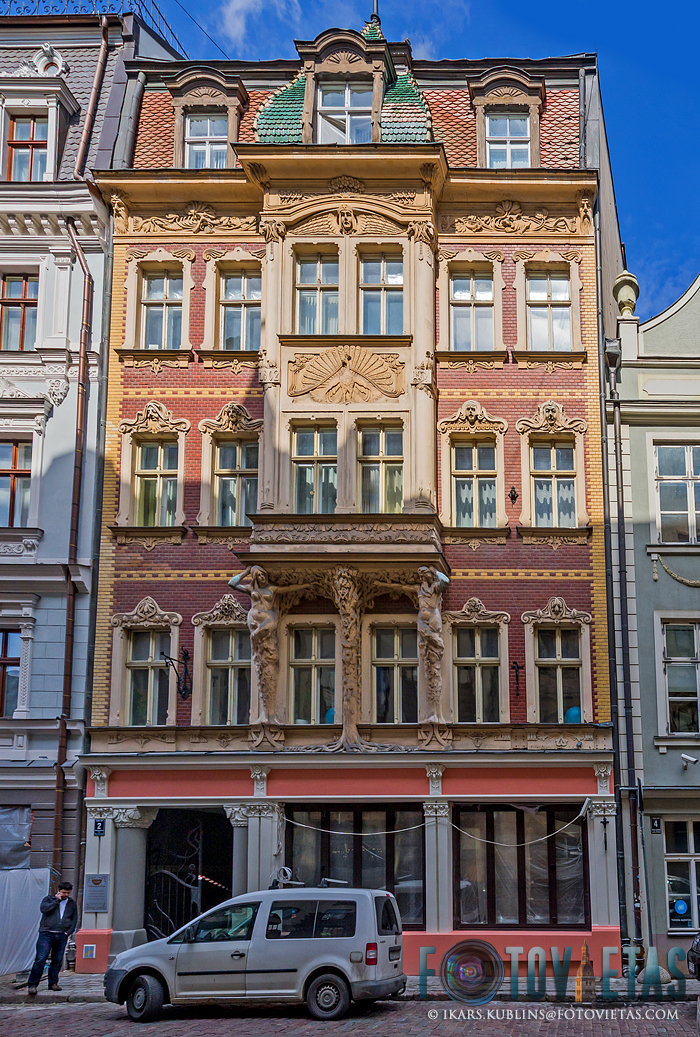
 Doma laukums 8a. Extraordinary and sophisticated building, almost like a "white sparrow" in the palette of Riga art nouveau. No wonder because it's designed by architect from St Petersburg, Nikolay Proskurnin and this is his only building in Riga. The building surprises with it's diverse styles and sizes of windows. It has a practical explanation because it was built as a mixed use building - on the first two floors there were shops, on the next two ones - offices and on the highest floors - apartments. The building's unique character is also defined by original stylization of corner gazebos, interplay of brown plastering and stone as well as in the expressive woman's figure seen below the central bay.
Doma laukums 8a. Extraordinary and sophisticated building, almost like a "white sparrow" in the palette of Riga art nouveau. No wonder because it's designed by architect from St Petersburg, Nikolay Proskurnin and this is his only building in Riga. The building surprises with it's diverse styles and sizes of windows. It has a practical explanation because it was built as a mixed use building - on the first two floors there were shops, on the next two ones - offices and on the highest floors - apartments. The building's unique character is also defined by original stylization of corner gazebos, interplay of brown plastering and stone as well as in the expressive woman's figure seen below the central bay.
 Jauniela 25/27. Very posh and decorated with vivid art nouveau mascarons, this is one of art nouveau wonders in Riga Old Town. It's built in 1903 as a tenement house, the building has a complicated structure because it was projected in several parts to better fit in the historical surroundings. Nowadays the building houses a restaurant and a hotel. The mascaron seen above the central entrance is one of most recognizable icons of Riga art nouveau.
Jauniela 25/27. Very posh and decorated with vivid art nouveau mascarons, this is one of art nouveau wonders in Riga Old Town. It's built in 1903 as a tenement house, the building has a complicated structure because it was projected in several parts to better fit in the historical surroundings. Nowadays the building houses a restaurant and a hotel. The mascaron seen above the central entrance is one of most recognizable icons of Riga art nouveau. 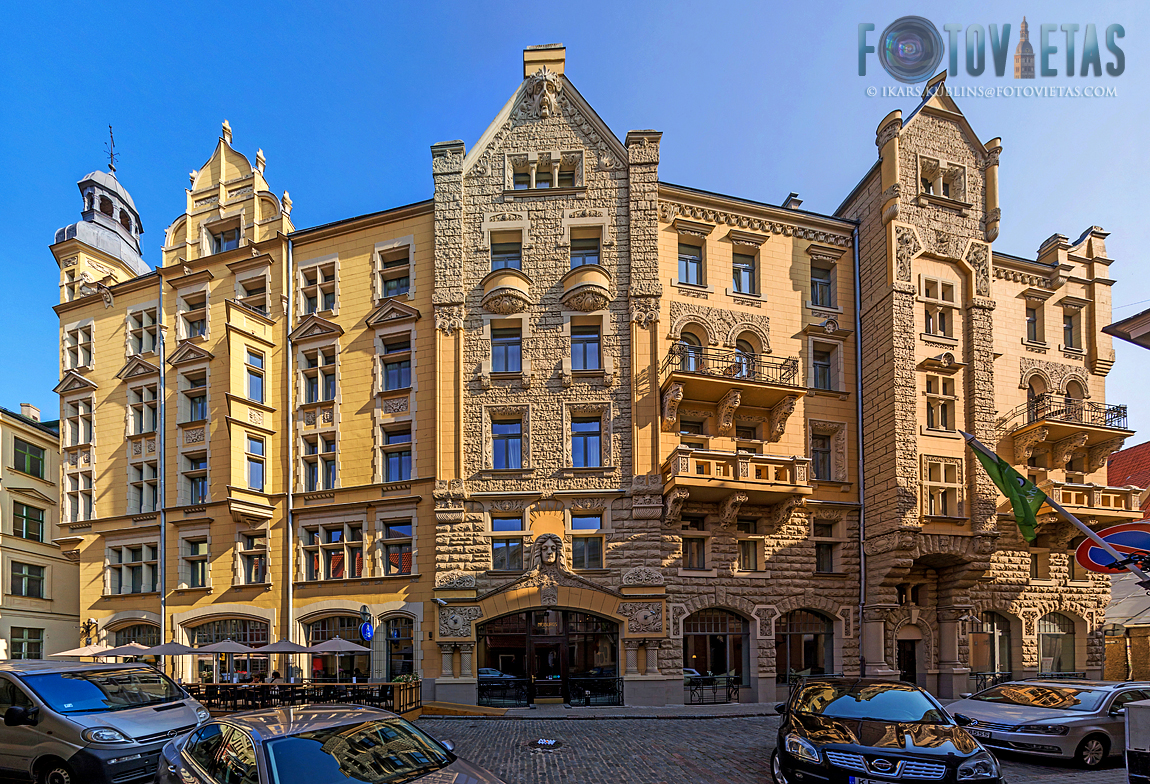
 Teātra street 9. The sculpture of Atlants who holds the globe on their shoulders above the roof of this extraordinary building is another one of most famous symbols of Riga's art nouveau. No less impressive is the balcony and also tiled edge of keyhole-shaped 5th floor window. At night, the globe is lightened up - it is intended as a symbol of humanity's progress. Art nouveau was booming in time when the world was full of hopes to a better future, new technologies and inventions appeared. In this sense, Teatra street 9 is one of most accurate embodiments of the spirit of it's time. The architects - Scheel and Scheffel (1904).
Teātra street 9. The sculpture of Atlants who holds the globe on their shoulders above the roof of this extraordinary building is another one of most famous symbols of Riga's art nouveau. No less impressive is the balcony and also tiled edge of keyhole-shaped 5th floor window. At night, the globe is lightened up - it is intended as a symbol of humanity's progress. Art nouveau was booming in time when the world was full of hopes to a better future, new technologies and inventions appeared. In this sense, Teatra street 9 is one of most accurate embodiments of the spirit of it's time. The architects - Scheel and Scheffel (1904). 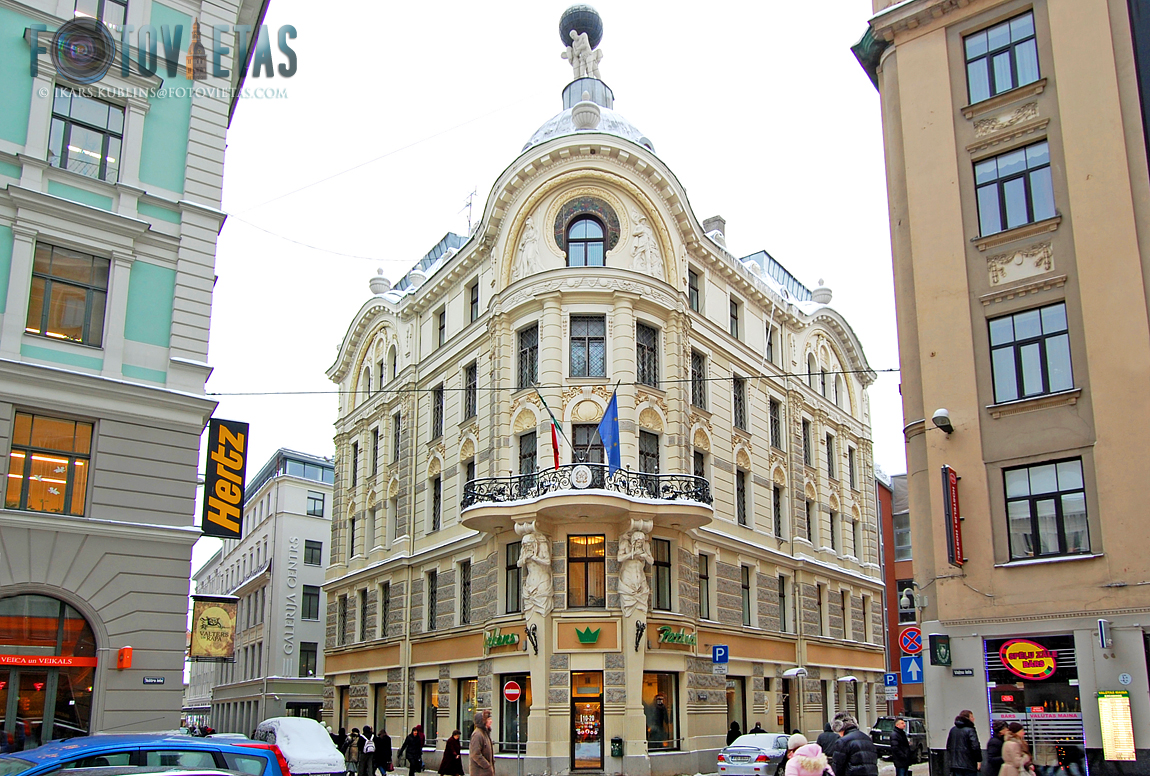
 Elizabetes iela 10b. Another one of the most iconic art nouveau buildings of Riga. Huge sculptural faces which tops this building's facade is often used as a symbolizing picture of Riga, from tourism brochures to art history books. In the buiding's context the sculptures symbolizes the struggle between world's rational and chaotic forces. Blue ceramic's plates are very eye pleasing addition to this heavily ornated building. Mikhail Eisenstein used the sketches from some architecture drawings collection, designed by Leipzig architects Georg Wünschmann and Hans Kozel.
Elizabetes iela 10b. Another one of the most iconic art nouveau buildings of Riga. Huge sculptural faces which tops this building's facade is often used as a symbolizing picture of Riga, from tourism brochures to art history books. In the buiding's context the sculptures symbolizes the struggle between world's rational and chaotic forces. Blue ceramic's plates are very eye pleasing addition to this heavily ornated building. Mikhail Eisenstein used the sketches from some architecture drawings collection, designed by Leipzig architects Georg Wünschmann and Hans Kozel. 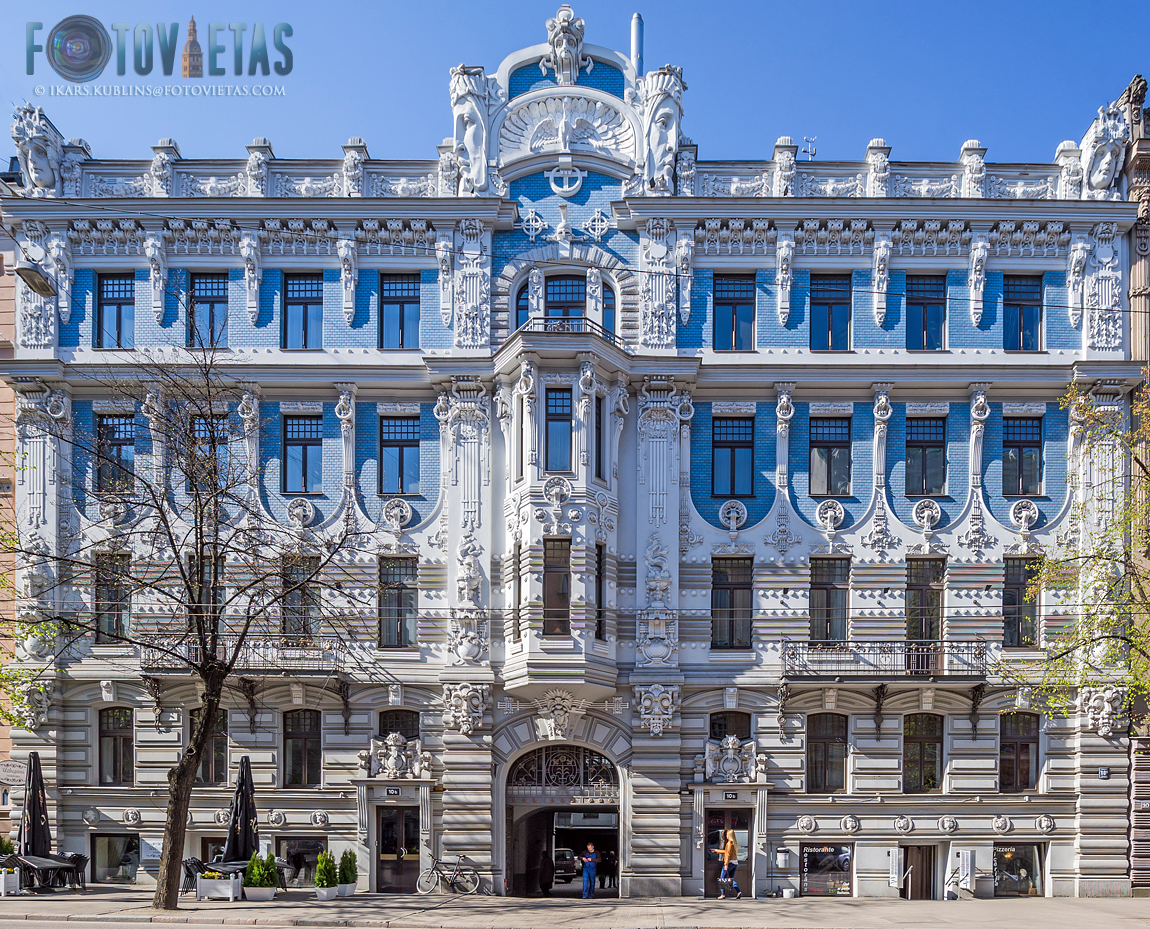
 Alberta iela 13. Different example of Eisenstein's talent - this is corner building and it forced the architect to recede from his habitual symmetrical compositional solutions. Alberta street 13 is very posh and satiated with decorative elements and symbols. The woman faces depicted in various emotional expressions, from happily laughing to screaming in fears. There's also brave knights, deceitful snakes, showing off peacocks, etc.
Alberta iela 13. Different example of Eisenstein's talent - this is corner building and it forced the architect to recede from his habitual symmetrical compositional solutions. Alberta street 13 is very posh and satiated with decorative elements and symbols. The woman faces depicted in various emotional expressions, from happily laughing to screaming in fears. There's also brave knights, deceitful snakes, showing off peacocks, etc. 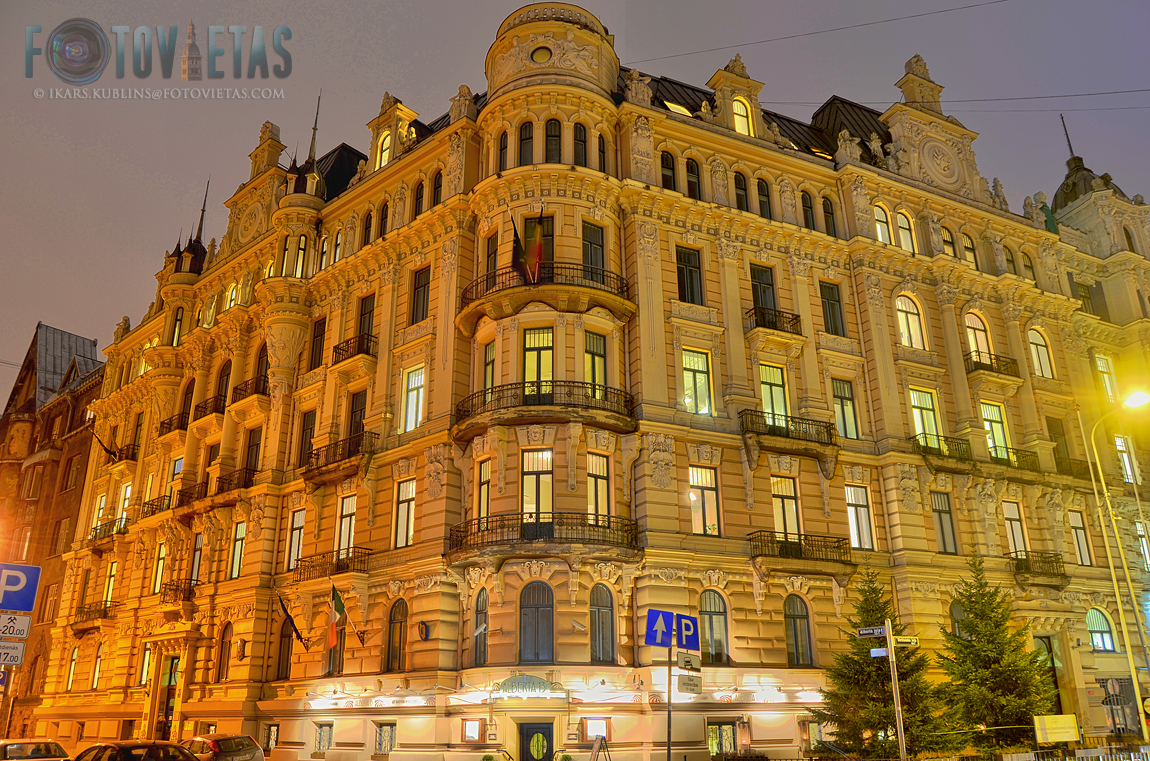
 Ģertrūdes street 23.
Ģertrūdes street 23. 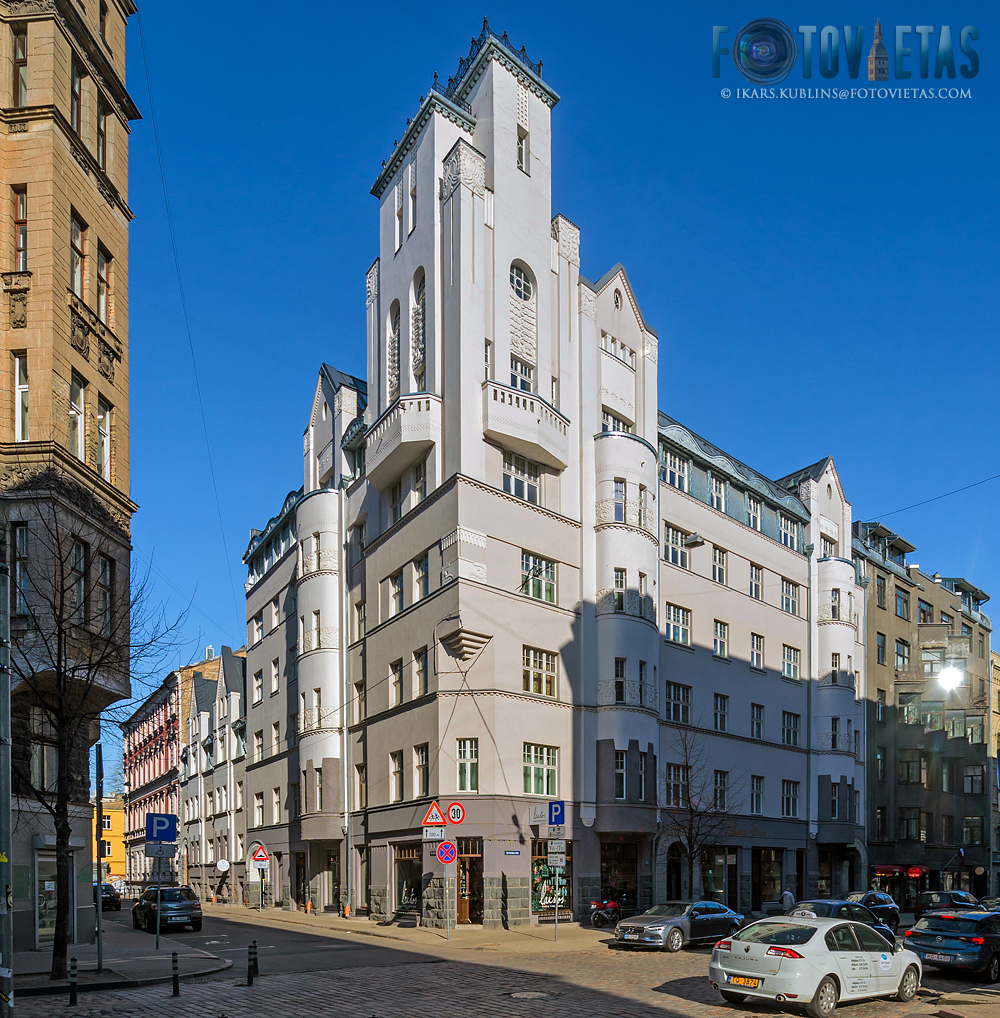
 Amatu iela 4. At the first moment it may seem that this building designed by Wilhelm Bokslaff is not belonging here - it doesn't associates with art nouveau. However it's just a good camouflage - although the building really has some neogothic style towers, the common composition of the facade is ingrained in art nouveau. Just look at the style of decors, streamlines, window openings. Interesting fact - the building which is so good at hiding it's real architectural nature, has housed the institutions which did the same - it has served as an office of both Nazi and Soviet counter-espionage administrations.
Amatu iela 4. At the first moment it may seem that this building designed by Wilhelm Bokslaff is not belonging here - it doesn't associates with art nouveau. However it's just a good camouflage - although the building really has some neogothic style towers, the common composition of the facade is ingrained in art nouveau. Just look at the style of decors, streamlines, window openings. Interesting fact - the building which is so good at hiding it's real architectural nature, has housed the institutions which did the same - it has served as an office of both Nazi and Soviet counter-espionage administrations. 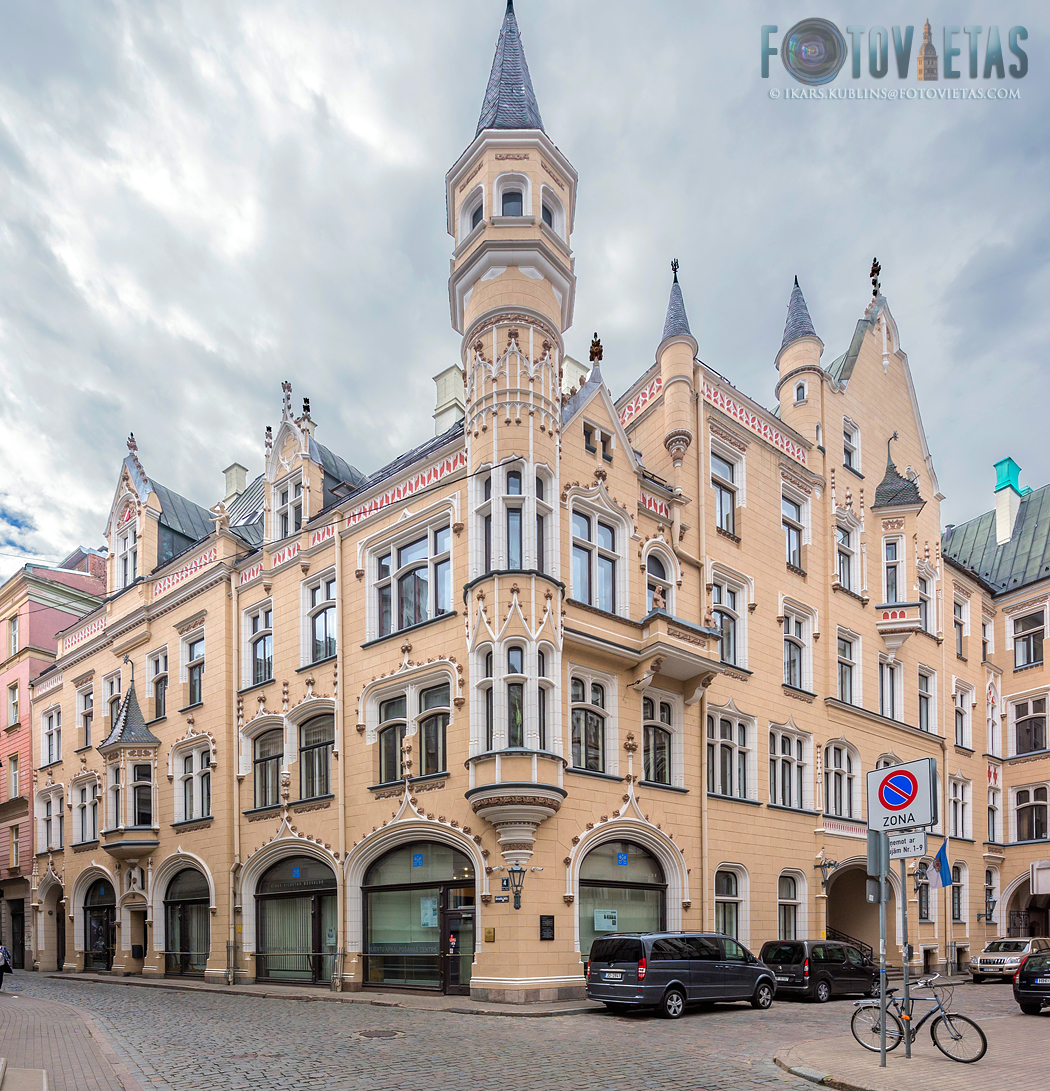
 Alberta street 2a. The essence of art nouveau charm, Alberta street 2a (built in 1906, designed by Mikhail Eisenstein) is so magnificent that it can hypnotize it's observer. The facade composition is strictly symmetrical here but the absolutely irrational, lovely "fake" 5th floor - the empty window openings which offers view to the sky - is the thing which gives this building a surreal, charismatic aureole. Also tourists beloved sphinkx sculptures which are put forward out of the facade on the pavement, the visual harmony between red and blue tiles, and, of course, sculptures, decors, mouldings makes this building a special star in art nouveau universe.
Alberta street 2a. The essence of art nouveau charm, Alberta street 2a (built in 1906, designed by Mikhail Eisenstein) is so magnificent that it can hypnotize it's observer. The facade composition is strictly symmetrical here but the absolutely irrational, lovely "fake" 5th floor - the empty window openings which offers view to the sky - is the thing which gives this building a surreal, charismatic aureole. Also tourists beloved sphinkx sculptures which are put forward out of the facade on the pavement, the visual harmony between red and blue tiles, and, of course, sculptures, decors, mouldings makes this building a special star in art nouveau universe. 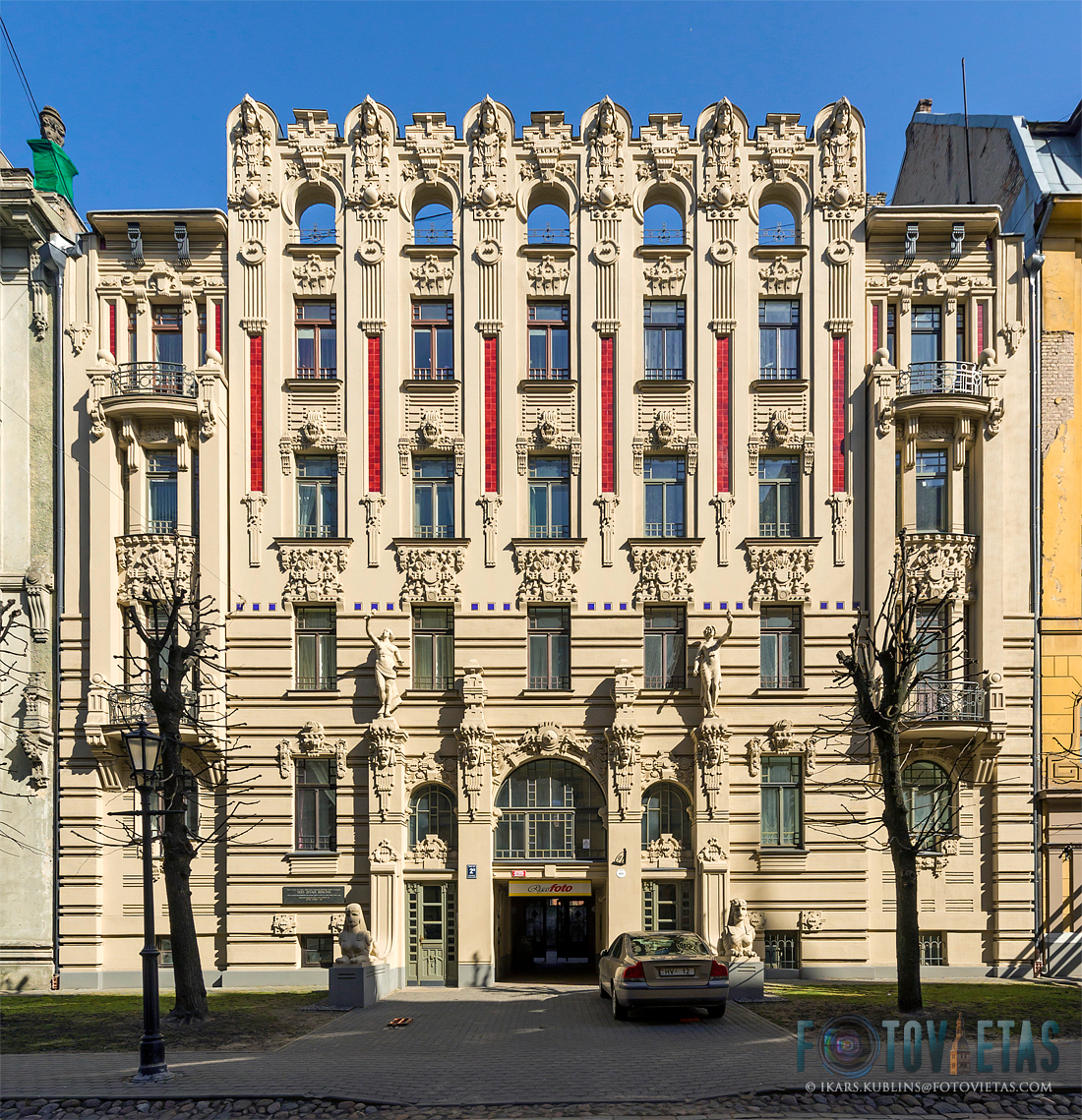
 Alberta iela 4. This Mikhail Eisenstein's designed building is labeled as the most outstanding and artistically original in Riga's art nouveau collection (although it's a little contradiction with the fact that some similar elements are used also in famous Secession building in Vienna). After a small "fight" with the second place owner, I can name Alberta street 4 as my Riga's art nouveau favorite as well. It's phantasmagoria and elegant facade rhythmic best of all embodies the role of art nouveau - to be as a messenger of a dream world in the material reality. Alberta street 4 can offer similar feelings like Gaudi's or Hundertwasser's
Alberta iela 4. This Mikhail Eisenstein's designed building is labeled as the most outstanding and artistically original in Riga's art nouveau collection (although it's a little contradiction with the fact that some similar elements are used also in famous Secession building in Vienna). After a small "fight" with the second place owner, I can name Alberta street 4 as my Riga's art nouveau favorite as well. It's phantasmagoria and elegant facade rhythmic best of all embodies the role of art nouveau - to be as a messenger of a dream world in the material reality. Alberta street 4 can offer similar feelings like Gaudi's or Hundertwasser's 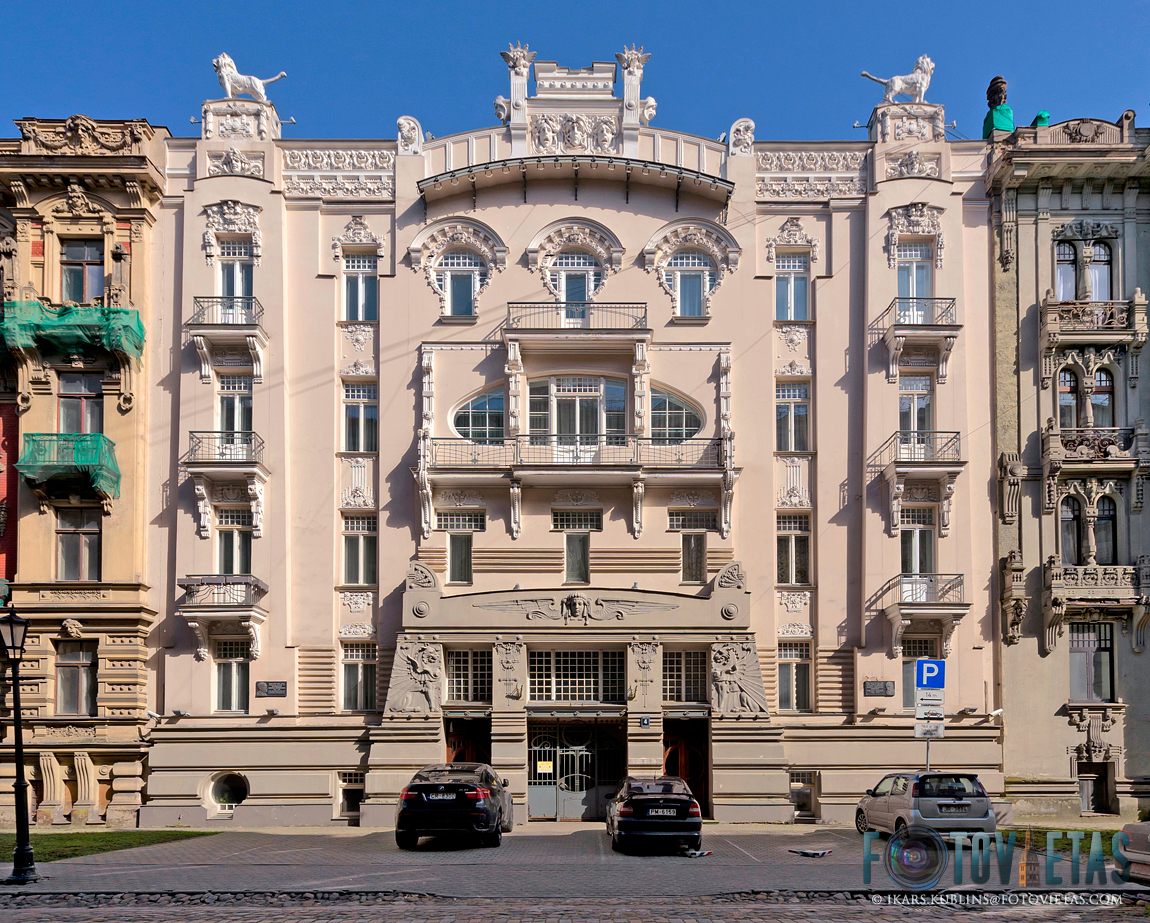




Post A Comment:
0 comments: